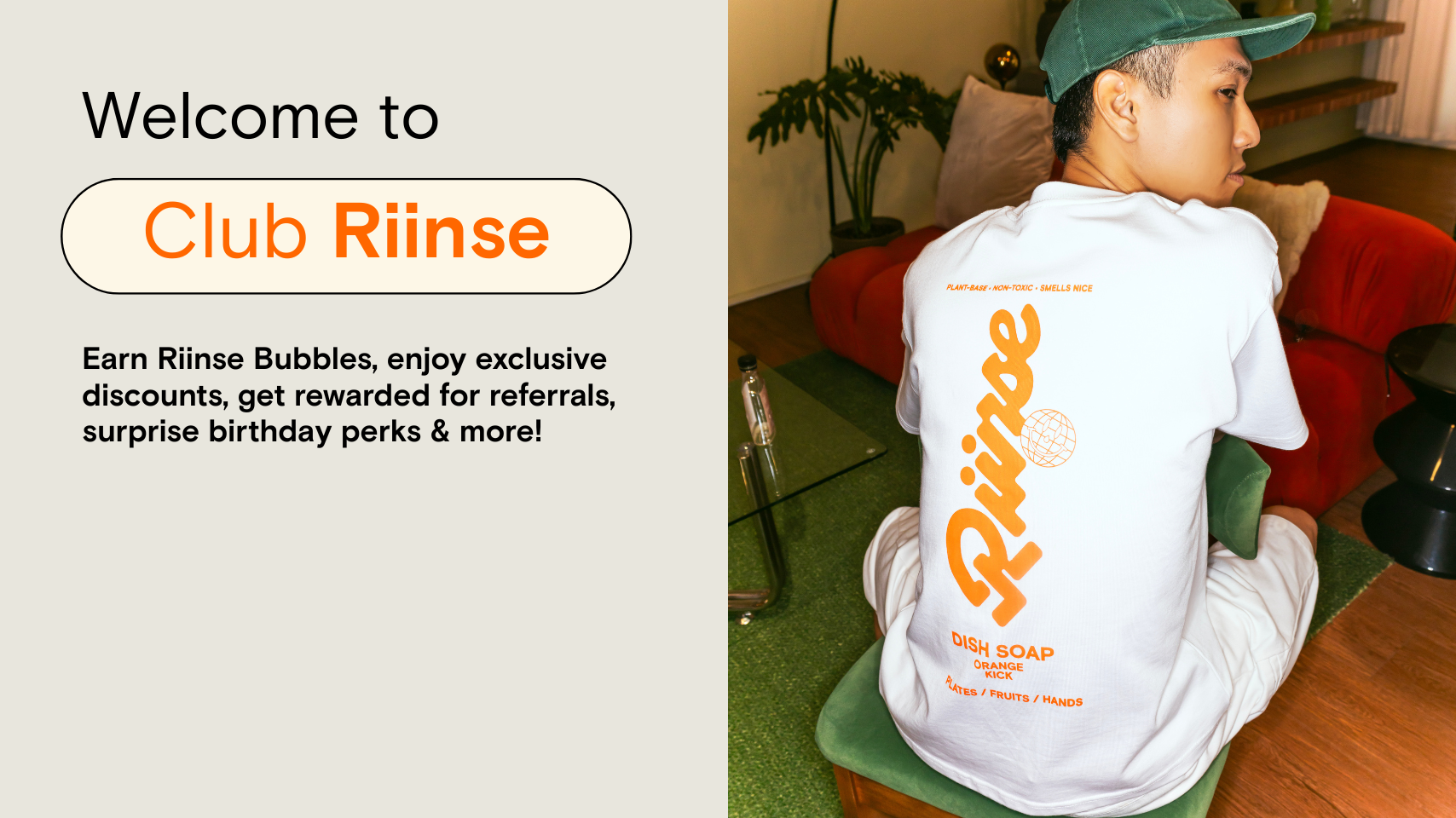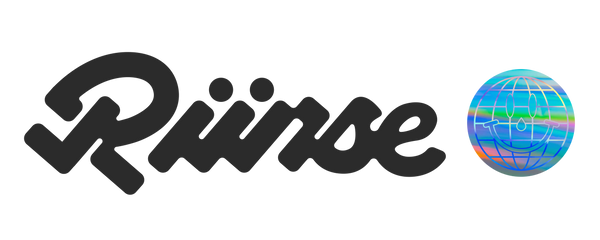
How It Works
Frequently Asked Questions
Explore this section to find comprehensive answers to all your questions about the loyalty program.
Club Riinse is our bubbly rewards program made to thank you for sticking with clean, plant-based products that actually work.
Every time you shop, refer a friend, or show us love online, you’ll earn BUBBLES—our fun points currency that can be redeemed for discounts on future orders.
Plus, members get early access to launches, special perks, and surprise treats (like birthday rewards!). It’s free to join, and the more you Riinse, the more you earn.
You can earn bubbles by signing up, following us on social media, placing an order, referring friends, and celebrating your birthday with us.
You can redeem your bubbles for discounts on purchases, free shipping, or special deals like buying a bundle and getting a discount on merchandise.
Your bubbles do not expire as long as you remain an active member of our loyalty program.
You can redeem bubbles for discounts off your purchases, free shipping, special product bundles, and more.
You need 800 bubbles to redeem for free shipping.
Yes, you earn bubbles for every purchase you make in our store. The number of bubbles earned depends on the amount spent.
Yes, some bubble discounts can be combined with other promotions such as product and shipping discounts.
You can refer friends through our referral program. They will receive a discount on their first purchase, and you will earn bubbles when they make a purchase.
Ingredient Library
We love being transparent about our ingredients because you deserve to know exactly what's in the products you use every day.
Using clean ingredients in our household cleaning products is crucial for several reasons:
Health Benefits
- Reduced Exposure to Harmful Chemicals: Non-toxic ingredients help avoid exposure to potentially harmful chemicals such as SLS, SLES, and parabens. These chemicals can cause skin irritation, allergies, and other health issues with prolonged exposure.
- Safe for Sensitive Skin: Clean ingredients are typically gentler on the skin, making them suitable for individuals with sensitive skin or allergies.
- Better for Children and Pets: Non-toxic products reduce the risk of accidental poisoning or adverse reactions in children and pets who might come into contact with cleaned surfaces.
Environmental Impact
- Biodegradability: Clean, plant-based ingredients are often biodegradable, meaning they break down more easily in the environment, reducing pollution and harm to wildlife.
- Sustainable Sourcing: Many non-toxic ingredients come from renewable resources, contributing to more sustainable production practices and reducing reliance on fossil fuels.
Efficacy and Safety in Household Use
- Effective Cleaning: Non-toxic, plant-powered ingredients can be just as effective, if not more so, than their synthetic counterparts. They can cut through grease and grime while being safe to use.
- Non-toxic Residues: These ingredients ensure that any residues left behind after cleaning are safe, especially important for items like dishes and utensils that come into direct contact with food.
Consumer Trust and Preferences
- Growing Awareness: Consumers are becoming increasingly aware of the health and environmental impacts of the products they use. Offering non-toxic, clean products can meet this growing demand and build brand loyalty.
- Regulatory Compliance: Many regions have stringent regulations regarding the use of certain chemicals in household products. Using clean ingredients helps ensure compliance with these regulations, avoiding potential legal issues and fines.

Good old water, aka H2O. The most common skincare ingredient of all. You can usually find it right in the very first spot of the ingredient list, meaning it’s the biggest thing out of all the stuff that makes up the product.
It’s mainly a solvent for ingredients that do not like to dissolve in oils but rather in water.
Cocamidopropyl Betaine
Biodegradable cleaning surfectant made from coconut oils
Super common ingredient in all kinds of cleansing products: face and body washes, shampoos and foam baths.
Number one reason for its popularity has to do with bubbles. Everyone loves bubbles. And cocamidopropyl betaine is great at stabilizing them.
Lauryl Glucoside
Vegetable Origin cleansing agent
A 100% vegetable origin, biodegradable, mild cleansing agent that gives moderate to high amount of foam. It's happy to work together with other surfactants (in general, that helps to create milder formulas).
Aloe Vera Extract
The extract coming from the juice containing leaves of the Aloe vera plant. It's usually a hydroglycolic extract (though oil extract for the lipid parts also exists) that has similar moisturizing, emollient and anti-inflammatory properties as the juice itself.
Benzalkonium Chloride
Organic Salt antiseptic
PEG-120 Methyl Glucose Dioleate
Corn derived thickening and cleaning agent that reduces irritation),
Citric Acid
Citrus fruit derived pH balancer
Citric acid comes from citrus fruits and is an AHA.
So citric acid is an exfoliant, that can - just like other AHAs - gently lift off the dead skin cells of your skin and make it more smooth and fresh.
Orange or Grapefruit Fragrance
The essential oil coming from the sweet orange or grapefruit. In the case of orange (and citruses in general), the essential oil is mainly in the peel of the fruit, so it's pretty much the same as the orange peel oil (also has the same CAS number - a unique ID assigned to chemicals).
Its main component is limonene (up to 97%), a super common fragrant ingredient that makes everything smell nice.
Sodium Benzoate
Vegan antimicrobial preservative
A helper ingredient that helps to make the products stay nice longer, aka preservative. It works mainly against fungi.
It’s pH dependent and works best at acidic pH levels (3-5). It’s not strong enough to be used in itself so it’s always combined with something else, often with potassium sorbate.
Formulated without:
Sodium Lauryl Sulfate (SLS)
What It Is: A detergent and surfactant commonly used in cleaning and personal care products to create lather.
Disadvantages:
- Skin Irritation: Can cause skin irritation, dryness, and allergic reactions, especially with prolonged exposure.
- Eye Irritation: May irritate the eyes, particularly in higher concentrations.
- Environmental Impact: Not easily biodegradable, potentially harmful to aquatic life.
Sodium Laureth Sulfate (SLES)
What It Is: A detergent and surfactant similar to SLS but modified to be slightly less harsh.
Disadvantages:
- Skin and Eye Irritation: Can still cause skin and eye irritation, although typically less severe than SLS.
- Contamination Risk: May be contaminated with 1,4-dioxane, a potential carcinogen, during the manufacturing process.
- Environmental Impact: Also not easily biodegradable and can affect aquatic ecosystems.
Colourants
What They Are: Synthetic dyes and pigments used to add color to products.
Disadvantages:
- Allergic Reactions: Some colorants can cause allergic reactions and skin irritation.
- Toxicity Concerns: Certain synthetic dyes have been linked to health issues, including cancer and hyperactivity in children.
- Environmental Impact: Can be harmful to the environment, particularly aquatic life, when washed down the drain.
Parabens
What They Are: Preservatives used to prevent the growth of bacteria and mold in products.
Disadvantages:
- Hormone Disruption: Can mimic estrogen in the body, potentially disrupting hormonal balance and contributing to health issues like breast cancer.
- Skin Sensitivity: May cause skin irritation and allergic reactions in some individuals.
- Bioaccumulation: Can accumulate in the body over time, raising concerns about long-term exposure.
Phthalates
What They Are: Chemicals used to make plastics more flexible and as solvents in personal care products.
Disadvantages:
- Hormone Disruption: Known endocrine disruptors, which can interfere with hormone function and reproductive health.
- Developmental Issues: Linked to developmental and reproductive toxicity, especially concerning for pregnant women and children.
- Environmental Impact: Persistent in the environment, potentially harming wildlife and ecosystems.
Using products without these ingredients helps protect your health and the environment.
